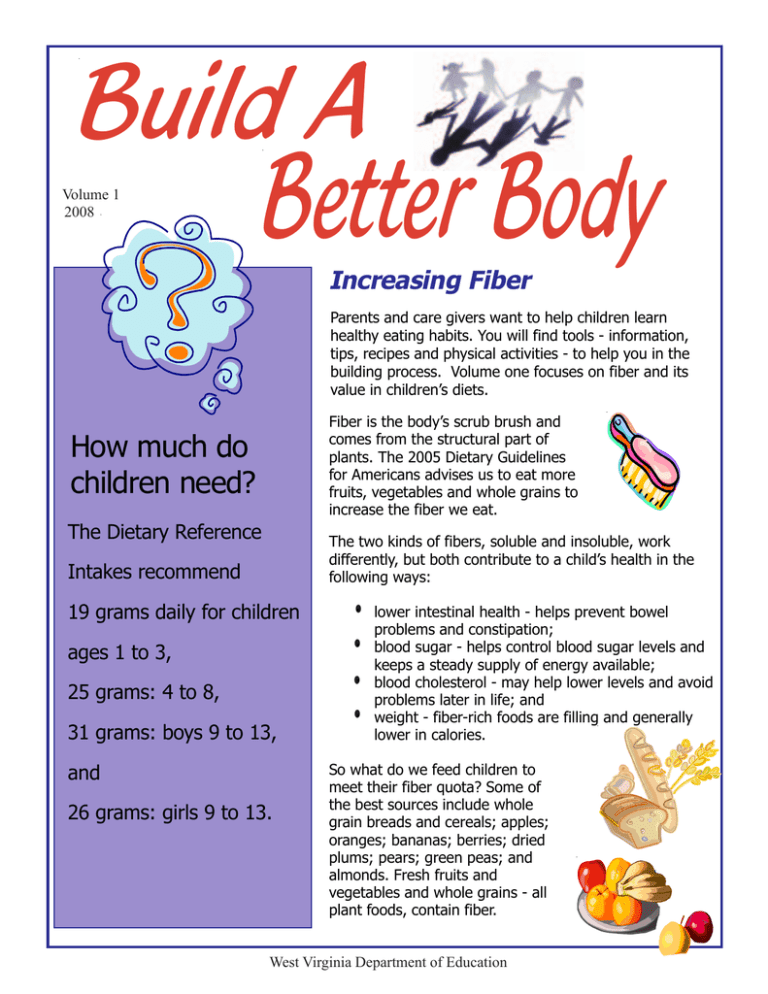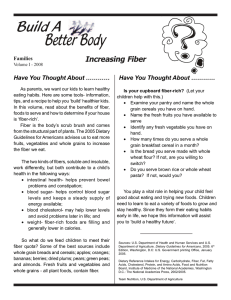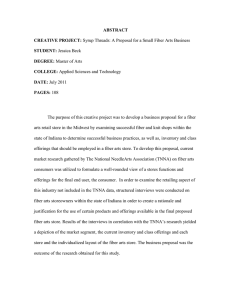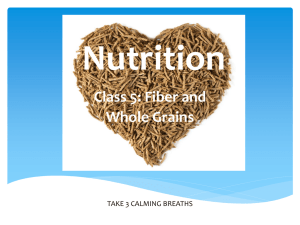Better Body Build A Increasing Fiber
advertisement

Build A Volume 1 2008 Better Body Increasing Fiber Parents and care givers want to help children learn healthy eating habits. You will find tools - information, tips, recipes and physical activities - to help you in the building process. Volume one focuses on fiber and its value in children’s diets. Fiber is the body’s scrub brush and comes from the structural part of plants. The 2005 Dietary Guidelines for Americans advises us to eat more fruits, vegetables and whole grains to increase the fiber we eat. How much do children need? The Dietary Reference The two kinds of fibers, soluble and insoluble, work differently, but both contribute to a child’s health in the following ways: Intakes recommend 19 grams daily for children ages 1 to 3, 25 grams: 4 to 8, 31 grams: boys 9 to 13, and 26 grams: girls 9 to 13. · lower intestinal health - helps prevent bowel problems and constipation; · blood sugar - helps control blood sugar levels and keeps a steady supply of energy available; · blood cholesterol - may help lower levels and avoid problems later in life; and · weight - fiber-rich foods are filling and generally lower in calories. So what do we feed children to meet their fiber quota? Some of the best sources include whole grain breads and cereals; apples; oranges; bananas; berries; dried plums; pears; green peas; and almonds. Fresh fruits and vegetables and whole grains - all plant foods, contain fiber. West Virginia Department of Education TIPS Add fiber-rich foods gradually to allow the body to adjust slowly. Ensure children drink adequate water daily. This is very important! Treat children to colorful foods they love by making funny faces out of sandwiches using whole grain pita bread stuffed with their favorite veggies. Use shredded carrots for hair, cucumbers for eyes and red pepper for the mouth. For extra crunch in salads, make a base of crunchy veggies and top with toasted whole grain bread crumbs. Serve with a tasty low-fat dressing. Make a cereal snack consisting of whole grain cereals, dried fruit and nuts if desired. Eaten by itself or with low-fat yogurt, this is a great snack to tide over hungry appetites. Build A Better Body Breakfast: make oatmeal a part of breakfast; pancakes from buckwheat; oatmeal muffins; or whole grain bagels. Top cereals or pancakes with fresh fruit or include dried fruit in muffins. Lunch or Dinner: serve sandwiches on whole grain breads; vegetables ‘au natural’ instead of processed (think baked potato with skin instead of prepared frozen fries); add berries, beans or nuts to salads; add beans, barley or lentils to soups; wrap sandwich fillings in whole grain tortilla shells and top with fresh salsa; and include fresh fruits and veggies with these meals. Serve whole grain pasta or brown rice for a nutty, rich taste. Snacks: make cookies from whole grains such as oatmeal or wholewheat flour and add dried fruit or nuts; incorporate pumpkin in muffins, breads or cookies; fresh fruit salad or a veggie plate. When carving the pumpkin for Halloween, save the seeds and toast them with your favorite spice. Build A Better Body NUTRITION TOOL! Soft Pretzels Ingredients: Frozen whole wheat bread dough Try add-ons such as cinnamon, toasted oats, chili powder, paprika, dried fruit, toasted pumpkin seeds, or rice crispies. Be daring! Method: Thaw dough and separate into 2 ounce portions. Allow children to roll out dough into a long rope and twist into a pretzel shape. Spray with cooking spray for a sticky surface and add favorite toppings or spices. Bake according to package directions. ACTIVITY TOOL! Sources: U.S. Department of Health and Human Services and U.S. Department of Agriculture. Dietary Guidelines for Americans, 2005. 6th Edition, Washington, D.C: U.S. Government printing Office, January 2005. Dietary Reference Intakes for Energy, Carbohydrate, Fiber, Fat, Fatty Acids, Cholesterol, Protein, and Amino Acids, Food and Nutrition Board, Institute of Medicine of the National Academies, Washington D.C.: The National Academies Press, 2002/2005. Team Nutrition US Department of Agriculture Shake, Rattle and Roll Children will gather around the room with enough space to move without bumping into each other. Instruct them to create a food move for everyone when you call on them. The other children will imitate the move until you signal stop. Moves might include: Sizzle like a potato cooking Snap like a green bean Shake like a milkshake Circle like a bagel Twist like a pretzel Shiver like a frozen treat Hop like a bubbly vegetable soup Rattle like beans Curl like a banana Build A Better Body Fiber Assessment: After reading the fact sheet, answer the following questions: 1. Name the two kinds of fiber found in food. 2. How does fiber contribute to a child’s well-being? 3. What food groups contain fiber-rich foods? 4. How much fiber do children need? 5. When adding fiber to the diet, add fiber-rich foods ____________ to allow the body to adjust slowly. 6. Name a way to add fiber to breakfast. 7. Name a fiber-rich food that could be served at lunch or dinner. 8. Children should drink plenty of _________ when increasing fiber. Assess your cupboard: 1. Examine your pantry and name the whole grain cereals you have on hand. 2. Name the fresh fruits you have available to serve. 3. Identify any fresh vegetable you have on hand. 4. How many times do you serve a whole grain breakfast cereal in a month? 5. Is the bread you serve made with whole wheat flour? If not, are you willing to switch? 6. Do you serve brown rice or whole wheat pasta? If not, would you? In accordance with federal law and U.S. Department of Agriculture (USDA) policy, this institution is prohibited from discriminating on the basis of race, color, national origin, sex, age, disability or retaliation. If you require information about this program, activity or facility in a language other than English, contact the USDA agency responsible for the program or activity, or any USDA office. If you require this information in alternative format (Braille, large print, audiotape, etc.) contact the USDA’s TARGET Center at (202) 720-2600 (Voice or TDD). To file a complaint of alleging discrimination, write: USDA, Director, Office of Civil Rights; 1400 Independence Avenue, S.W., Washington, D.C. 20250-9410, or call toll free (866) 632-9992 (Voice). TDD users can contact the USDA through local relay or the Federal Relay at (800) 877-8339 (TDD) or (866) 377-8642 (relay voice users). USDA is an equal opportunity provider and employer. WEST VIRGINIA BOARD OF EDUCATION Dr. Steven L. Paine State Superintendent of Schools Delores W. Cook, President; Priscilla M. Haden, Vice President; Ronald B. Spencer, Secretary Robert W. Dunlevy, Member; Barbara N. Fish, Member; Burma Hatfield, Member Lowell E. Johnson, Member; Gayle C. Manchin, Member; Jenny N. Phillips, Member Brian E. Noland, Ex Officio; James L. Skidmore, Ex Officio; Steven L. Paine, Ex Officio





